The Modern Louisiana Maneuvers - US Army Center Of Military History
The Modern Louisiana Maneuvers - US Army Center Of Military History
The Modern Louisiana Maneuvers - US Army Center Of Military History
You also want an ePaper? Increase the reach of your titles
YUMPU automatically turns print PDFs into web optimized ePapers that Google loves.
erational and staff assignments, and others<br />
who served him and the <strong>Army</strong> as colleagues,<br />
planners, and consultants. He usually communicated<br />
with these individuals informally<br />
and sporadically, depending on the information<br />
he needed and the type of advice he<br />
thought he required. Sometimes, Sullivan<br />
convened groups of these people to gather<br />
different perspectives on the issues confronting<br />
him. Those who knew him well often<br />
submitted unsolicited memos, essays, or articles<br />
to stimulate his thinking, even after<br />
he became Chief of Staff.29<br />
Historians were among those whom he<br />
consulted most frequently. He had known<br />
MG William A. Stofft since they were students<br />
together in the Armor <strong>Of</strong>ficers Advanced<br />
Course at Fort Knox, 1964-1965,<br />
and he had maintained contact with Stofft<br />
as the latter moved on to become the <strong>Army</strong>'s<br />
Chief of <strong>Military</strong> <strong>History</strong>, Director of Management<br />
on the <strong>Army</strong> Staff, and, after 1991,<br />
Commandant of the <strong>Army</strong> War College.<br />
Stofft provided historically based inSights<br />
and advice, a function that BG Nelson,<br />
Stofft's successor as Chief of <strong>Military</strong> <strong>History</strong>,<br />
fulfilled as well. Sullivan had also known<br />
historian Dr. Roger ]. Spiller since his tenure<br />
as Deputy Commandant of the Command<br />
and General Staff College. <strong>The</strong>se historians<br />
provided Sullivan with additional<br />
grist for his intellectual milPo<br />
<strong>The</strong> range of former colleagues with<br />
whom the Chief maintained contact was extensive.<br />
In addition to Franks, Peay, Ross,<br />
and others with whom he routinely interacted<br />
anyway, he enjoyed close and longstanding<br />
ties with COL Lon E. Maggart. A<br />
fellow Armor officer, Maggart had long been<br />
associated with the community of <strong>Army</strong> intellectuals,<br />
beginning with his membership<br />
in GEN William E. DePuy's "Boathouse<br />
Gang" of doctrine writers who had produced<br />
the 1976 edition of FM 100-5 under GEN<br />
DePuy's guidance. This manual had integrated<br />
lessons learned from the 1973 Arab<br />
Israeli War with other important doctrinal<br />
concepts to produce a startlingly new approach<br />
to <strong>Army</strong> operations. Maggart had<br />
14<br />
served with Sullivan in the 3d Armored Division<br />
and the 1st Infantry Division and had<br />
maintained close contact with him over the<br />
intervening years, prOViding Sullivan a<br />
sounding board for ideas and a source of<br />
fresh thoughts 31 Still another former subordinate<br />
was COL Robert D. Rodgers. Rodgers<br />
had worked for Sullivan and Maggart in both<br />
the 3d Armored Division and the 1st Infantry<br />
Division, and he had maintained contact<br />
with Sullivan over the years as we1l 32 COL<br />
Richard A. Cowell, who came to the LAM<br />
Task Force as head of the Issues and then<br />
the Synchronization Directorate and later<br />
became the Task Force's last long-term Director,<br />
had served as Sullivan's cavalry squadron<br />
commander in the 1st Infantry Division.<br />
This list does not begin to exhaust the number<br />
of other officers to whom Sullivan turned<br />
for advice and information and with whom<br />
he "thought out loud" and discussed different<br />
ideas 33<br />
Consultants in various fields also made<br />
contributions to Sullivan's thinking. Dr. Lynn<br />
Davis, then the Head of the RAND Arroyo<br />
<strong>Center</strong>, had received extensive briefings from<br />
TRADOC's DCS for Analysis (DCS-A) on the<br />
LAM concept and supported it. She then<br />
conversed with Sullivan several times and<br />
wrote several notes and essays in early 1992<br />
to help him develop his own emerging concept<br />
of the <strong>Louisiana</strong> <strong>Maneuvers</strong> 34 Another<br />
consultant whose input had some impact<br />
was LTG (Ret.) Frederic J. Brown, Sullivan's<br />
former boss as the Armor <strong>Center</strong> Commander,<br />
and an <strong>Army</strong> intellectual of long<br />
standing. Brown corresponded with Sullivan<br />
sporadically on the future course of land<br />
warfare and the <strong>Army</strong>.35 Sullivan also made<br />
a point of discussing the <strong>Louisiana</strong> <strong>Maneuvers</strong><br />
with GEN (Ret.) Jack N. Merritt, President<br />
of the Association of the United States<br />
<strong>Army</strong>, in order to gain the insights that the<br />
head of the <strong>Army</strong>'s support organization<br />
could provide 36<br />
In all of Sullivan's deliberations he considered<br />
ways to take advantage of distributed<br />
interactive simulations (DIS) to speed<br />
the process of change, shorten test and ac-<br />
<strong>The</strong> <strong>Modern</strong> <strong>Louisiana</strong> <strong>Maneuvers</strong>
















